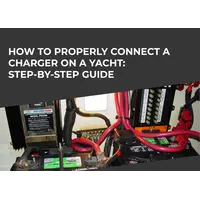Before you start reading these recommendations, please visit the section of our marketplace that includes echo sounders for fishing from the world's leading manufacturers. Just to make sure that the choice of these gadgets is huge when it comes to both price and functions: screen size, sensor (transducer) characteristics, frequencies, etc. Therefore, guided by our suggestions and free consultations from our experts, you can choose echo right now sounder for fishing that will exactly suit your needs and the fishing methods you prefer.
But after you have made your choice and bought an echo sounder for fishing, you have to figure out whether it is possible to improve the accuracy of the data of this useful device. And here the recommendations of topRik experts will help you - experienced sailors who rely on their own experience in using various echoes sounders for fishing. As regular readers of our blog know, topRik experts only offer what they themselves have tested and experienced at sea.
Of course, in our team there are avid fishermen who have experience in fishing with amateur and professional echo sounders in the sea, on rivers, in closed reservoirs both in summer and in winter. Therefore, we know that the most advanced sonar sometimes requires individual settings depending on the fishing conditions.
Even if at the time of purchase of echo sounder you are satisfied with the factory settings recommended by our consultants, it is possible that you want to change the fishing conditions. This may also require changing settings to improve the accuracy of the data that your echo sounder provides. The good news is that this can sometimes be achieved without replacing the device with a more advanced model. Just figure out the settings of what you already have.
Of course, you must understand that wireless models, with any settings, will not compare with the picture quality, accuracy and variety of data with an on-board echo sounder, and dual-beam models will not provide a 3D image.
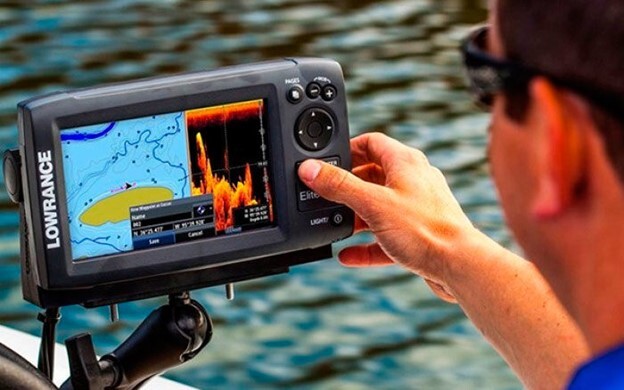
Main Factors Affecting the Accuracy of an Echo Sounder
The quality and accuracy of the information that an echo sounder can provide a fisherman is influenced by several main factors. These are the characteristics of the sensor (transducer), as well as the choice of frequencies at which the echo sounder can operate.
Transducer Quality and Power
It often happens that the user, when choosing an echo sounder, studies its display, delving into the resolution and type of screen, determining the number of beams and the amount of energy consumption. But he/she forgets about such an important part of the fishing echo sounder as the transducer. It is this sensor that is responsible for the accuracy of the information that you see on the screen. The sensor emits ultrasound into the water and receives a reflected signal back from obstacles: bottom relief, algae and other aquatic plants, any objects located under the boat, and of course, fish.
Sensors can be either wired (can be attached to the side of the boat, the bottom or it can have a universal mount). It can be wireless (usually made in the form of a float). Wireless options are mainly used in echo sounders that are designed for fishing from the shore.
The power produced by the emitter of an echo sounder (or chartplotter echo sounder) is one of the most important characteristics of the sensor.
The more powerful the transducer, the “longer-range” the device is, the greater the depth at which it can operate normally.
It should be noted that different manufacturers may indicate different types of power in the characteristics: in some cases it is peak (maximum power at the moment of a single pulse), in others it is RMS (root mean square power, calculated over a certain period of time and resulting below peak).
Therefore, we can say that the role of this parameter is usually purely for reference, and when choosing, you should focus on points that are closer to practice, for example, on the scanning depth, which directly depends on the power of the transducer.
However, we should not forget that the practical capabilities of an echo sounder depend on a number of other parameters, ranging from operating frequencies and angles to the quality of the receiver and the features of signal processing algorithms.
Echo Sounder Operating Frequency
Frequency in this context is the number of pulses per second sent by the sensor. Let's look at which frequencies and, as a result, the rays that are most actively used by leading manufacturers of echo sounders. We will also find out how the difference in the choice of frequencies affects the ability to identify fish, determine the bottom topography, depths and other features of the underwater space.
200 kHz
The most common frequency for 2D echo sounders. Works to a depth of approximately 300 meters, creates a beam width of up to 60 degrees (provided the sensitivity level is set to high) and gives the cleanest and sharpest picture.
Below is a diagram of how, when switching the beam, the angles in degrees will change depending on what frequency and sensitivity we have selected in the menu.
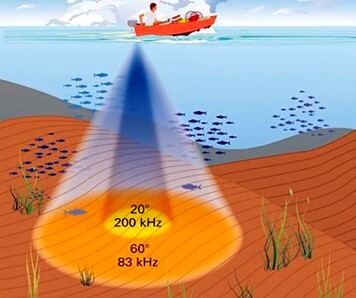
This beam itself is narrow for a clearer depiction of the bottom, but when we increase the sensitivity parameter, it expands and captures more underwater objects, such as fish.
What is it for? It is clear that a wide beam is good for finding fish, but good things should also be in moderation. If the beam is too wide, it will collect everything around the boat. A mess of a mass of arcs or fish will appear on the screen, but it will be very difficult to understand where all this wealth is under water.
But that's not all. There is one more nuance: if the device scans the bottom with a wide beam, then serious inaccuracies will begin between the readings on the screen and the real bottom topography. Especially when passing along the coastal dump. So a narrow beam is rather good if the exact bottom topography is important first of all.
If your fish finder has a choice of frequencies between 200, 83 and 50 kHz, 200 kHz will be the main frequency for the vast majority of your fishing. The remaining two will only be auxiliary for special conditions, which will be discussed below.
It’s also worth immediately warning that the three mentioned frequencies cannot work simultaneously in the echo sounder. Even if all three are on the menu, only two will work at a time. In this case, when both frequencies are turned on, the echo sounder itself will divide the screen into two windows. In one there will be a picture with one frequency, in the other - with another. Which frequencies will work for you depends on the sensor and the echo sounder menu settings. A marine transducer can operate at frequencies of 200 and 50 kHz, a conventional transducer at 200 and 83 kHz.
50 KHz
The so-called “marine” frequency. Designed for powerful penetration of sea water. Creates a beam of about 90 degrees, which is capable of imaging the bottom at depths of up to 1500 meters. Why is its beam wider than the beam of the previous frequency? Logically, this is done to counteract the confusing properties of pitching. In practice, when this frequency is turned on, the “clicks” from the sensor become rare but strong. Thus, this beam penetrates deeper into salty, denser water.
But we think that you are unlikely to need this frequency even for sea fishing at depths of up to 100 meters. It is no coincidence that the beam at a frequency of 50 kHz is wider than the classical one at a frequency of 200 kHz. In this case, the beam width will smooth out the distortion of the real depth as a result of pitching. That is, a wider beam will better image the bottom when the ship is pitching at sea. When to turn it on? When the frequency of 200 kHz can no longer cope. It does not reach the bottom, and therefore does not display the bottom topography due to significant depth, pitching or movement speed.
83 kHz
Echo sounder sensors with this frequency are designed for use in shallow water - depths of 6 meters or less. When it is turned on, the beam width increases to 120 degrees (when the sensitivity is set to maximum). Accordingly, the bottom capture becomes twice as large as compared to a beam that provides a frequency of 200 kHz.
On the one hand, it’s good - there is more coverage of the bottom, on the other hand, the accuracy of drawing the bottom decreases, especially when passing along the coastal slope, when one side of the beam touches its upper edge and the other touches the lower edge.
Therefore, it is better not to abuse the inclusion of this frequency unnecessarily. It makes sense to turn it on in frankly small places - less than 4 meters. Although this is unlikely to increase the chances of seeing a fish standing to the side. Most likely, she will swim away from under the boat before she gets into the range of the beam.
It’s a different matter when we plumb-catch catfish using quok or horse mackerel in the sea. A beam that is 2 times wider will most likely allow you to see tackle or fish that are not caught in the thinner cone of the 200 kHz beam. And here it makes complete sense to try to use it.
If you need such a beam in addition to the basic 200 kHz, look for a model with the Pro wording at the end of the name of entry-level models. Or check if it is available on advanced models without the Pro inscription, for example, in the HDS and Elite series.
For the new generation of echo sounders DSI, HDI and LSS, two new frequencies have been introduced - 455 and 800 kHz.
455 kHz
It allows you to penetrate the water column further to the sides and deeper, by approximately 30 percent compared to the frequency of 800 kHz, but is somewhat inferior in quality. More precisely, in the subtlety of drawing the details of bottom structures.
800 kHz
It somewhat shortens the length of the side rays and begins to “get lost” at a depth of more than 18 meters with a significantly silted bottom. On the other hand, when searching quickly at full speed (of course, not at significant depths), we would prefer to turn it on. Because at such a pulse sending frequency, the picture has a chance to be depicted in more detail than at a frequency of 455 kHz, not to mention the classic 200, 50, 83 kHz.
As our practice shows, 455 kHz is still used much more often, and switching to 800 kHz only makes sense either at depths of less than 6 meters or for fine drawing with the lower high-frequency beam, and then to a depth of 15 meters.
The beam operating at these frequencies has a different shape, flat, in the form of a lemon slice in cross-section. That is, if you look at the projection from the beam cone from above, it will be a strongly flattened ellipse, perpendicular to the movement, and not a circle from the base of the cone, like a classic 2D echo sounder.
On the one hand, the narrow beam shape reduces the fish catching area when the boat is stationary, or you are using an echo sounder on ice in winter. On the other hand, this technology provides amazing image quality of the underwater landscape and fish as well. It also shows a picture of what is happening right at the bottom (50 cm above and below), which is practically impossible with a classic echo sounder with beam frequencies of 200, 50, 83 kHz.
Correct Placement and Installation of the Transducer
In many ways, the correct operation of the echo sounder sensor depends on the quality of installation. Although the kit comes with installation instructions, not everyone believes that all of its requirements should be followed. Don't listen to this opinion. Recommendations for installing the transducer should be followed to the letter!
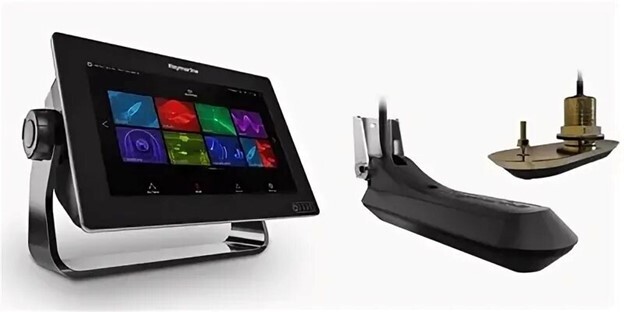
Proper transducer installation should ideally:
- ensure its contact with the bottom at any speed with the steering wheel turned completely left and right at the maximum possible speed;
- eliminate the sensor's response to the boat's roll;
- provide the ability to display a school of fish and large snags at maximum speed;
- exclude mechanical impact from ice floes, logs or hard algae;
- eliminate maximum interference from engine operation;
- eliminate interference from electrical and electronic equipment.
Transducer housings come in all shapes and sizes. Most of them are made of plastic, but some of the transducers designed for installation in the hull of a boat are made of bronze. As we have already said, the size of the crystal determines the frequency and angle of radiation. In turn, the dimensions of the converter housing depend on the dimensions of the crystal located in it.
There are currently four main types of converter housing:
- through hulls (mounted through the ship's hull);
- hulls attached to the inner wall of the ship's hull;
- portable;
- transom mounted.
Through-hull transducers are inserted into a hole drilled in the hull of the boat. As a rule, they are equipped with a long rod, which is passed through the body and secured with a nut of the appropriate size. For punts, installation is limited to this. To install the transducer vertically along the side of a vessel with a V-shaped hull, you will need a wooden or plastic fairing. Through-hole transducers are typically installed on inboard-engined boats, ahead of rudders, propellers, and shafts.
Type 2 transducers are bonded with epoxy resin directly to the inside wall of the fiberglass hull of the vessel. Sound is transmitted and received through the hull of the boat, causing the sounder to become less effective (the depth of the sounder will be lower than that of a transom-mounted sounder). The hull of the boat must be made of solid fiberglass. Don’t even try to “pierce” the body made of aluminum, wood or steel with the beams of the echo sounder. Sound does not travel through air, so if the inside of the boat's hull is reinforced with a structure made of wood, metal or foam, it will have to be dismantled before installing the echo sounder. Another disadvantage of this type of fish finder is that it cannot be optimally tuned to the arcing calls of fish. However, along with the disadvantages, there are also significant advantages. Firstly, it will not be broken by a snag or a stone, because... it is located inside the yacht. Secondly, it, without protruding from the hull of the boat and without interfering with the flow, and being installed where the flow of water smoothly flows around the hull, works quite well, as a rule, at high speeds of the vessel. Thirdly, it will not become overgrown.
Portable transducers, as their name suggests, are temporarily attached to the hull of a vessel. They are usually attached using one or more suction cups. Some portable transducers can also be attached to an electric motor for trolling.
Transom transducers are mounted on the transom of the boat and are located in the water, slightly below the bottom of the boat.
Recommendations for Placement
The optimal location of the transducer on the boat hull depends largely on the type of boat or yacht. But the following requirements for installing an echo sounder sensor will be common to them.
To ensure optimal transducer performance, it is important to position it as close to the boat's centerline as possible in calm waters.
Do not install the transducer behind spacers, fittings, water inlets or outlets or anything else that creates air bubbles or creates water turbulence.
Do not install the transducer in a location where it may be damaged during transportation, towing, or storage.
On single engine boats, do not install the transducer in the path of the propeller. On boats with two engines, install the transducer between the propellers whenever possible. The transducer may create cavitation, which will cause poor boat performance and may damage the propeller.
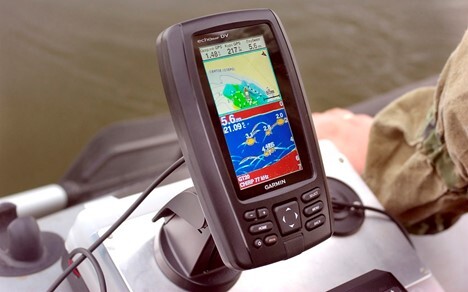
Transom Installation
Among the four types of transducers listed above, transom transducers are the most popular by far. The carefully designed transom transducer will work on any boat (except inboard powered boats), including at high boat speeds.
This option solves the problem of cavitation interference, which is a serious obstacle to sonar operation at high speeds. If the water flow around the transducer is uniform, the transducer will send and receive signals without problems. If the flow of water is “heavy” under the influence of bad weather or the edges of the vessel, it becomes turbulent so much that air separates from the water in the form of bubbles. This phenomenon is called cavitation.
If air bubbles pass over the transducer in which the crystal is located (the active element in the sensor), “noise” is displayed on the echo sounder screen. The fact is that the echo sounder is designed to work in water, not in the air. If air bubbles pass over the transducer, the signal is reflected from the bubbles back to the sensor. Since the air is adjacent to the transducer, these reflections are very strong. They interfere with stronger signals reflected from the bottom, underwater objects, and fish, making them difficult or impossible to distinguish.
To solve this problem, the converter needs a housing that water can flow around without creating turbulence. This is quite difficult due to the many requirements placed on a modern converter. It should be compact so that it does not interfere with the outboard motor or impede the flow of water behind it. It should be easy to install on the transom so that installation can be done with a minimum of holes. It must “be able” to recline to avoid damage when colliding with any objects.
The problem of cavitation is not limited to the shape of the converter. The hulls of many boats themselves promote the formation of air bubbles that create a curtain over the face of the transom-mounted transducer. This is especially problematic on aluminum boats, due to the hundreds of rivets protruding from the hull, each creating its own stream of bubbles, especially when the boat is moving at high speed. To avoid this problem, you need to install the front of the transducer so that the flow of air bubbles passes over it. In other words, the sensor bracket must be installed as low as possible on the transom.
The transducer should extend 1/8” beyond the fiberglass boat hull or 3/8” beyond the aluminum hull. When installing the transducer, make sure it is parallel to the bottom.
Make sure the transducer remains underwater when the boat is moving at high speeds.
To prevent water from seeping into the transom, treat the threads of all screws with a special marine sealant.
Mortise and Surface Mounting
The choice of mounting method for the transducer and echo sounder largely depends on the type and design of the boat. For example, the sensor can be glued to the inner surface of the bottom of a plastic boat with epoxy resin, since the housing material will not interfere with the operation of the transducer. But you still have to cut out some of the plastic to bring the sensor closer to the water.
Of course, installation with clamps, brackets and other mounting accessories makes the process much easier. But not all boats can use this installation scheme. But it guarantees maximum strength of the fastenings. In addition, mounting on brackets allows you to adjust the position of the transducer, while mounting by insertion does not allow this possibility.
A good option, especially at first, when the optimal attachment point has not yet been established, would be to use a removable clamp rather than a permanent connection.
If you are flush-mounting the transducer and its body is made of bronze, then make sure that it does not form a galvanic couple with the material of the boat or vessel. If this is the case, then they need to be isolated from each other using rubber, otherwise active corrosion is possible.
Taking Into Account External Factors
For the correct operation of the transducer and the echo sounder itself, some other factors in addition to power, frequency and angle should be taken into account. A fiberglass, metal or wooden vessel in the water element experiences many types of exposure to an aggressive environment for it. By taking these external factors into account in your echo sounder settings, you can improve the accuracy of the readings.
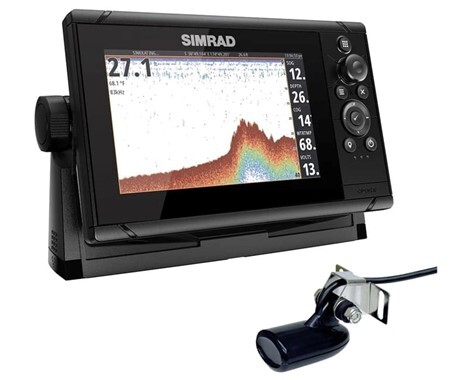
Influence of Weather Conditions
Unless your fish finder's transducer includes CHIRP scanning technology or more advanced technologies that deliver ultra-clear and detailed images at speed, you will have to manually adjust the scrolling speed of the screen as weather conditions change.
To effectively “read” the underwater space and correctly transmit data to the screen in real time, the speed of the vessel must be between no less than 4 and no more than 10 km/h, optimally 5-6 km/h. For ease of visual understanding, this is the speed of a fast human step. Such a seemingly simple task can become complicated under the influence of strong winds or currents. When the yacht is moving against a significant wind or current, the illusion of sufficient speed may arise. And vice versa, when going with the wind or current, you will want to increase the gas. To correctly solve our problems (high-quality, truthful pictures), the speed of 5-6 km/h should be relative to the bottom, and not the feeling of the water.
In such situations, the speed indicator on the GPS will be very helpful. This is one of the important arguments in favor of purchasing an echo sounder/chartplotter. In a nutshell, the motto is: “don’t trust your eyes and ears - trust the number on the GPS screen!”
And of course, let’s not forget about the roll during a strong side wave, which also distorts the echo sounder data.
Water Temperature
You will also need to monitor the water temperature at the fishing spot and, if necessary, adjust the echo sounder settings to match the actual conditions. Water temperature has a significant impact on the life of fish. The fish is cold-blooded, and its body temperature always matches the temperature of the surrounding water. In winter, fish metabolism slows down in cold water. During this period, she needs approximately four times less food than in summer. Most fish do not spawn unless the water temperature is within a fairly narrow range. The surface temperature sensors built into many of our fish finders help determine the top water temperatures that are most favorable for different species of fish to spawn. For example, trout die in rivers where the water becomes too warm. Perch and other species of fish eventually die if they accumulate in lakes where the water does not warm up enough in the summer. And although some fish are less susceptible to temperature changes than others, each breed has its own specific temperature range within which it tries to stay. The fish that gather near the surface of the water in deep areas are attracted precisely by the favorable temperature for them. We believe that is where she feels most comfortable.
In lakes, the temperature in the space between the surface and the bottom is rarely the same. Typically, a warmer layer of water is followed by a colder one. The boundary between two layers is called a thermocline. The depth and thickness of the thermocline can vary depending on the time of year and time of day. Deep lakes may have two or more thermoclines. This is significant because many species of game fish like to sit directly in it or slightly above or below it. Often the small fish will be above the thermocline, while the larger game fish will be resting in it or just below. Fortunately, this difference in temperature is reflected on the sonar screen. The greater the temperature difference, the more clearly the thermocline is visible on the screen.
Salinity and Density of Water
The type of water in which the echo sounder is operated largely determines its effectiveness. Sound waves travel easily in clear, fresh water, and this is the case in most lakes. In salt water, sound is absorbed and reflected by suspended matter.
Those most susceptible to sound wave scattering are the higher frequencies, which are unable to travel through salt water as well as lower frequencies. Part of the challenge of operating in salt water is that it is an extremely dynamic environment (the world's oceans, in fact).
Wind and currents constantly mix the water in it. Under the influence of waves, air bubbles are formed and mixed in the water, scattering the echo sounder signal. Microorganisms such as algae and plankton scatter and absorb the echo sounder signal. The minerals and salts in water do the same. Fresh water is also affected by winds, currents and microorganisms living in it, but still less than salt water.
Silt, sand, and vegetation on the bottom absorb and scatter the echo sounder signal, weakening the response echo. Rock, shale, coral and other hard objects reflect the echo sounder signal well. You will see the difference by looking at the screen. A soft, muddy bottom appears as a thin line, while a hard, rocky bottom appears as a wide stripe.
Therefore, do not forget to change the echo sounder settings when you change your fishing location: you leave a fresh body of water and go out to sea.
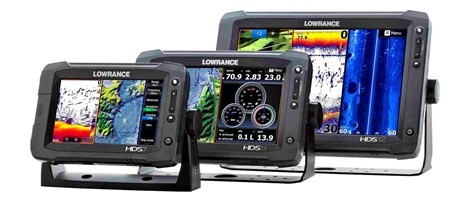
Maintenance And Care of the Echo Sounder and Transducer
Like any electronic equipment associated with the water element, the echo sounder and transducer require preventive inspection and care. Preventative checks of the echo sounder and sensor are carried out in accordance with the operating instructions. In the event of a breakdown, you should contact a manufacturer's representative, especially if the warranty period is still valid.
Regular Cleaning and Inspection
High-quality stationary echo sounders have varying degrees of protection from water. They have a waterproof body. But you should remember that this is not a floating device, so you can use floats for insurance.
After fishing, the echo sounder is wiped clean from dirt and stains with a special compound for electronic devices with a screen. The check is carried out in accordance with the operating instructions; it may differ for each type of echo sounder.
It is much more difficult with transducers, because they are in water, experiencing not only mechanical and other aggressive influences, but also becoming overgrown with aquatic microorganisms.
To prevent excessive fouling, make it a rule to clean the accessible surface of the hull from aquatic life after each fishing trip.
Use of Antifouling Coatings
Currently, anti-fouling is exploring new surfaces other than the hulls of yachts and boats. Now you can purchase an anti-fouling coating to treat the transducer of your fish finder. New compositions of anti-fouling paints for echo sounder sensors have excellent characteristics:
- durable water-based formula;
- they are safe for plastic surfaces;
- they do not interfere with the sonar signal.
These will not only free you from regular cleaning of the transducer, a rather unpleasant, scrupulous job that can easily damage the device, but will also extend its service life. Specialized antifouling compounds provide protection against algae, barnacles, annelids, tunicates, bryozoans, hydroids and other aquatic microorganisms. One treatment is enough for several seasons.
Quality Cables and Connectors
If your new fish finder does not come with the appropriate cables, when selecting them, remember that the cables and connections determine the accuracy of data transfer.
Feel free to consult the topRik marketplace specialists - they will select cables and connectors that are fully compatible with your equipment and other yacht systems.




